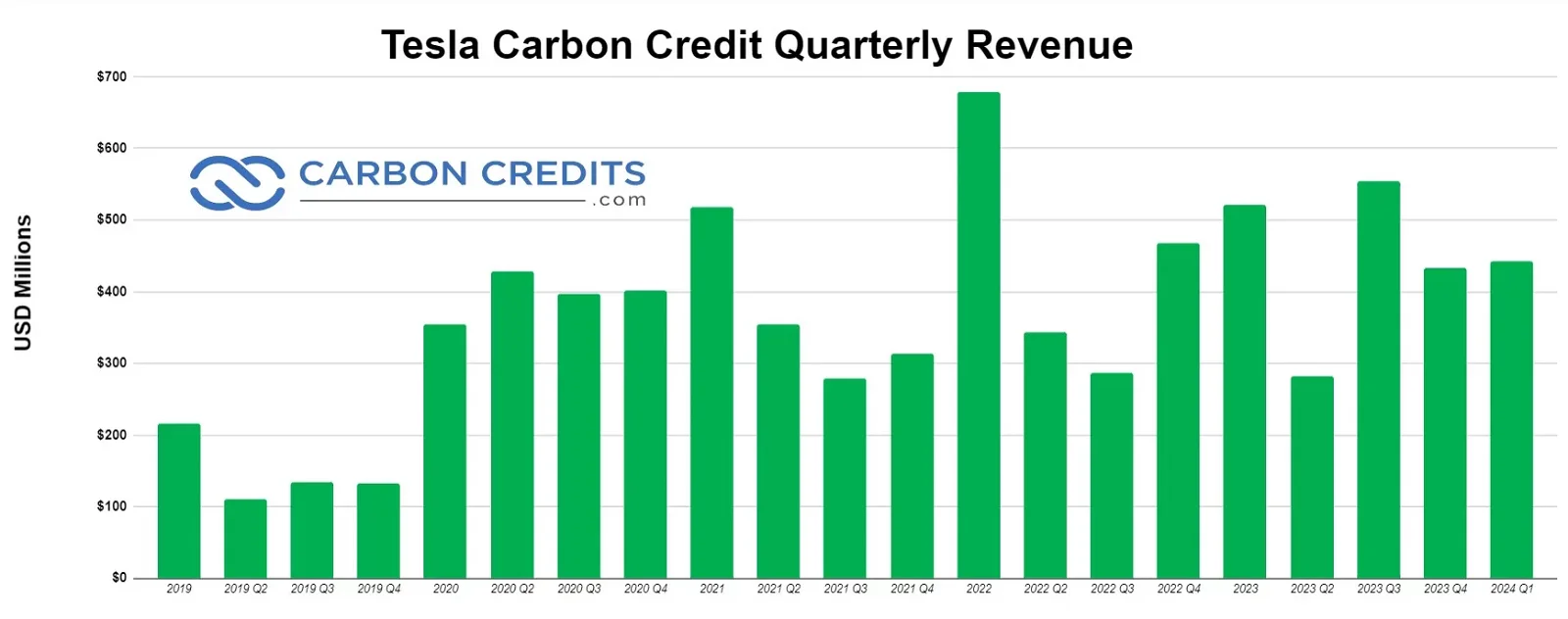Elon Musk’s Tesla continues to capitalize on the need of its competitors to comply with emissions standards, a business model that has proven highly profitable for the electric vehicle (EV) company. As the EV giant incurs minimal costs to earn these carbon credits, the revenue from their sale translates to pure profit.
While the specific recipients of these credits remain undisclosed, this revenue stream has been vital for Tesla’s financial success.
Tesla’s Green Cash Flow: Profiting from Emissions Compliance

In its recent first-quarter 2024 filings, the company reported a $442 million income from the sale of carbon credits (automotive regulatory credits). This figure represents a slight 2% increase from the previous quarter of Q4 2023, which is $433 million.
- Remarkably, this credit revenue accounts for a whopping 38.6% of the company’s Q1 2024 net income ($1,144 million).
However, Tesla’s profits took a significant hit in the first quarter, falling 55% to $1.13 billion compared to a year ago. This decline was attributed to a prolonged strategy of cutting EV prices and various unforeseen challenges that impacted the company’s financial performance.
Despite reporting revenue of $21.3 billion in Q1 2024, representing a 9% drop from the previous year, Tesla’s earnings fell short of analysts’ expectations. Operating income also decreased by 54% to $1.2 billion compared to the same period last year.
The gradual ramp-up of the updated Model 3 production at the Fremont factory in California contributed to the difficulties. The company also noted that global EV sales faced pressure as many automakers prioritized hybrids over electric vehicles.
In a report by S&P Global Commodity Insights, automakers are increasingly embracing plug-in hybrid EVs as a more affordable short-term solution on their journey toward full electrification.
In China, the share of battery electric vehicles (BEVs) within the plug-in electric vehicle (PEV) market declined by 10% points to 57.0% in February compared to the same period last year. This trend of declining BEV share is also observed in the United States and Germany. Both the U.S. and the European Union (EU) are adapting their PEV targets based on feedback from the industry.
Behind the dipping financial results, Tesla managed to generate more revenue from its regulatory credits. And the hybrid approach of other carmakers means they have to purchase carbon credits from the EV giant. The price for the carbon credit remains discreet between Tesla and the buyers.
Since the company started selling carbon credits to its peers, this revenue stream has become a billion-dollar bonanza for Tesla. Last year, the automaker generated a total annual income from carbon credits amounting to $1.79 billion. That’s a record high so far for the company’s automotive regulatory credit revenue.
Beyond Cars: Tesla’s Surge in Energy Storage Deployment
While automotive revenues experienced a decline, Tesla saw growth in other segments of its business, particularly in energy storage, which is becoming increasingly profitable for the company. As Megapack installations continue to increase and fleet expands, Tesla anticipates consistent profit growth in this segment.
In Q1 2024, energy storage deployments reached a record high of 4.1 GWh. Additionally, revenue and gross profit from Energy Generation and Storage reached all-time highs.
Compared to the same period last year, revenues were up 7% to $1.6 billion, and gross profit surged by 140%. This growth was primarily driven by increased Megapack deployments, although there was a slight decrease in solar installations. Energy Generation and Storage remains Tesla’s highest margin business.
In addition, Tesla generated $2.28 billion in revenue from services, which includes income from its Supercharger network. This revenue stream is expected to grow further as more automakers, such as Ford, GM, Rivian, and VW, adopt Tesla’s North American Charging Standard technology.
Tesla’s Carbon Credit Surprises and Future Innovations
Despite previous expectations that carbon credit income would decline as competitors ramped up electric vehicle (EV) production, Tesla has been surprised by sustained revenue in this area.
In 2020, the company’s former CFO Zachary Kirkhorn anticipated a decrease in the significance of this revenue stream over time. However, contrary to these predictions, Tesla’s earnings from regulatory carbon credits have not experienced a significant decline. In fact, last year’s earnings slightly exceeded the income from the previous year.
Despite the profit dip, Tesla used its earnings report to highlight its future initiatives. Notably, it emphasizes focus on advancements in autonomy through AI and the introduction of new products built on a next-generation vehicle platform. The company significantly increased its research and development spending, allocating $1.1 billion in the first quarter, a 49% rise from the same period in 2023.
Elon Musk underscored the company’s commitment to investing in the future, despite current challenges. Tesla aims to expedite the development of a new vehicle lineup, with production anticipated to begin in early 2025.
Musk emphasized that these new vehicles, including more affordable models, will leverage aspects of both the next-generation platform and the existing ones. This enables for production on the same manufacturing lines as the current vehicle lineup.
Tesla’s Q1 results, though showing a decline in profits, sparked a surge in share prices, rising by as much as 12% following the announcement. Investors seemed more interested in Tesla’s forward-looking statements regarding future products, particularly introduction of cheaper vehicles by 2025.
Musk emphasized during the earnings call that while some automakers are shifting towards plug-in hybrids, Tesla believes that battery electric vehicles will ultimately dominate the market. And their strategy remains focused on EVs despite the challenges faced in the industry.



